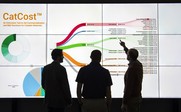News
BETO Accepting Applications for Funding Opportunity on “Robust Catalytic Processes”
Catalytic processes for the conversion of biomass and waste resources to sustainable aviation fuel, renewable diesel, and marine fuel is a primary topic area in BETO’s 2022 Waste Feedstocks and Conversion R&D funding opportunity announcement. BETO encourages applicants to collaborate with ChemCatBio, and concept papers are due April 18. Visit the EERE Exchange for specific areas of interest, metrics, and submission requirements.
ChemCatBio Director Presents at ABLC 2022
Director Josh Schaidle gave a presentation on ChemCatBio during the “Catalyst and Catalytic Upgrading” panel of the Advanced Bioeconomy Leadership Conference (ABLC) 2022 summit, which was held March 16–18 in Washington, D.C. View Director Schaidle’s presentation for an overview of the consortium, avenues for partnership, and its latest efforts to accelerate the catalyst and process development cycle.
Work With ASTM D32 To Provide and Vet Standards for Future Catalysis R&D
ASTM Committee D32 on Catalysts is recruiting qualified members to help develop standards for catalysts. It is also seeking participants in interlaboratory studies to vet those standards with the proper equipment and capabilities to determine precision, reproducibility, and bias. With jurisdiction over 40 ASTM standards and guides—and counting—the committee currently focuses on heterogeneous catalysts, but also considers homogenous catalysts. Contact ChemCatBio Steering Committee Member Mariefel Olarte for more information on the committee, the interlaboratory studies, and how to get involved.
Catalyst Property Database Gets Improved User Interface
Updated in March 2022, the Catalyst Property Database (CPD) now has a cleaner, more modern user interface, including new features that make it faster and easier to find the most relevant results. CPD search returns now default to only adsorption energy results that meet a standard set of criteria. As a result, users can now start with the most relevant details before editing the standard filters to return deeper results.
ChemCatBio Presentations Now Online from Bioenergy Technologies Office 2021 Peer Review
Researchers provided updates on ChemCatBio’s growing research and development (R&D) portfolio during the U.S. Department of Energy’s Bioenergy Technologies Office 2021 Project Peer Review. Explore our R&D portfolio for a complete list of presentations on active and completed projects.
Catalysts of Change: Outstanding Early Career Researchers
In this section, we spotlight interns, graduate students, and early career researchers whose outstanding contributions are driving ChemCatBio’s mission to accelerate the catalyst and process development cycle for bioenergy applications.
Xiaokun (Claire) Yang, Los Alamos National Laboratory
Xiaokun (Claire) Yang is a staff scientist who joined Los Alamos National Laboratory (LANL) to work on biomass catalytic conversions. She hopes to be an influential contributor on using renewable elements from biomass to produce valuable fuels and chemicals by conducting R&D on catalyst development, reaction design, process engineering, and transformative technologies ranging from lab-scale research to real-world applications.
Claire has been instrumental in developing technology for both the catalytic upgrading of biochemical intermediates and Sironix/LANL industrial partnership projects within ChemCatBio—the latter of which received a 2020 R&D 100 “Special Recognition in Green Technology” award based on Claire’s contributions. She is an active researcher in multiple BETO projects, and her recent work on the conversion of corn residues to tactical military fuels has been highlighted in Scientific American, Popular Mechanics, and Forbes.
|
|
 |
Sean Tacey, National Renewable Energy Laboratory
Sean Tacey is a postdoc who joined the National Renewable Energy Laboratory (NREL) to work on computational catalysis research for carbon dioxide conversion and biomass upgrading. He hopes to stay on as a researcher at NREL and continue contributing to catalytic carbon transformation research for renewable energy production. Sean is a thought leader in the application of computational chemistry results to guide catalyst design. He is a proactive and responsive team member, and his individual initiative has accelerated the progress and elevated the impact of research within the Consortium for Computational Physics and Chemistry, as well as the ChemCatBio Data Hub.
|
|
 |
Mond F. Guo, Pacific Northwest National Laboratory
Mond Guo is a staff engineer who joined Pacific Northwest National Laboratory to work on heterogeneous catalysis in the renewable space. He hopes to develop and promote alternative pathways toward sustainable aviation fuels and chemicals through his research. During Mond’s short scientific career, he has already published several high-impact works and received three patents, with two more pending, in oxygenate conversion to fuels and chemicals.
|
|
 |
Nicole LiBretto, National Renewable Energy Laboratory
Nicole LiBretto is a postdoc who joined NREL to design nanoparticles for the conversion of waste carbon feedstocks. She hopes to understand the role of catalyst speciation and how structure-function relationships govern catalytic activity. Nicole has distinguished herself by applying her extensive expertise with in situ X-ray spectroscopy, which she developed during her graduate career, to understand the active sites in a range of catalyst materials for conversion of renewable C1 feedstocks to fuel-range hydrocarbons. Concurrently, she has developed highly controlled nanostructured catalysts through solution synthesis methods to better enable correlation of the active sites with the catalyst structure.
|
|
 |
Recent Research Highlights
3 Ways the Catalyst Property Database Can Accelerate Biofuels Research
 |
|
Developed by NREL scientists with the support of BETO, the Catalyst Property Database is an online library of catalyst property data designed to make it faster and cheaper to identify the right catalyst formula for specific biofuel production processes. Read a BETO blog on why this powerful tool might drive innovation in catalysis. |
CatCost Online Tool Offers Insight Into Catalyst Manufacturing Cost and Environmental Impact
 |
|
The road to commercial adoption of new catalytic materials can be long, expensive, and fraught with risk. ChemCatBio scientists developed CatCost—a free and publicly available catalyst cost estimation tool—to help reduce such barriers. A paper published in Nature Catalysis demonstrates the functionality of CatCost with a case study evaluating the manufacturing costs and environmental impact of three high-performance catalysts for the conversion of biomass to fuels and chemicals. Learn more about the paper’s findings. |
The Accelerator is a newsletter of ChemCatBio, a consortium of eight DOE national labs dedicated to accelerating the catalyst and process development cycle for bioenergy applications. ChemCatBio is part of the Energy Materials Network, funded by the Bioenergy Technologies Office in DOE’s Office of Energy Efficiency and Renewable Energy.
|